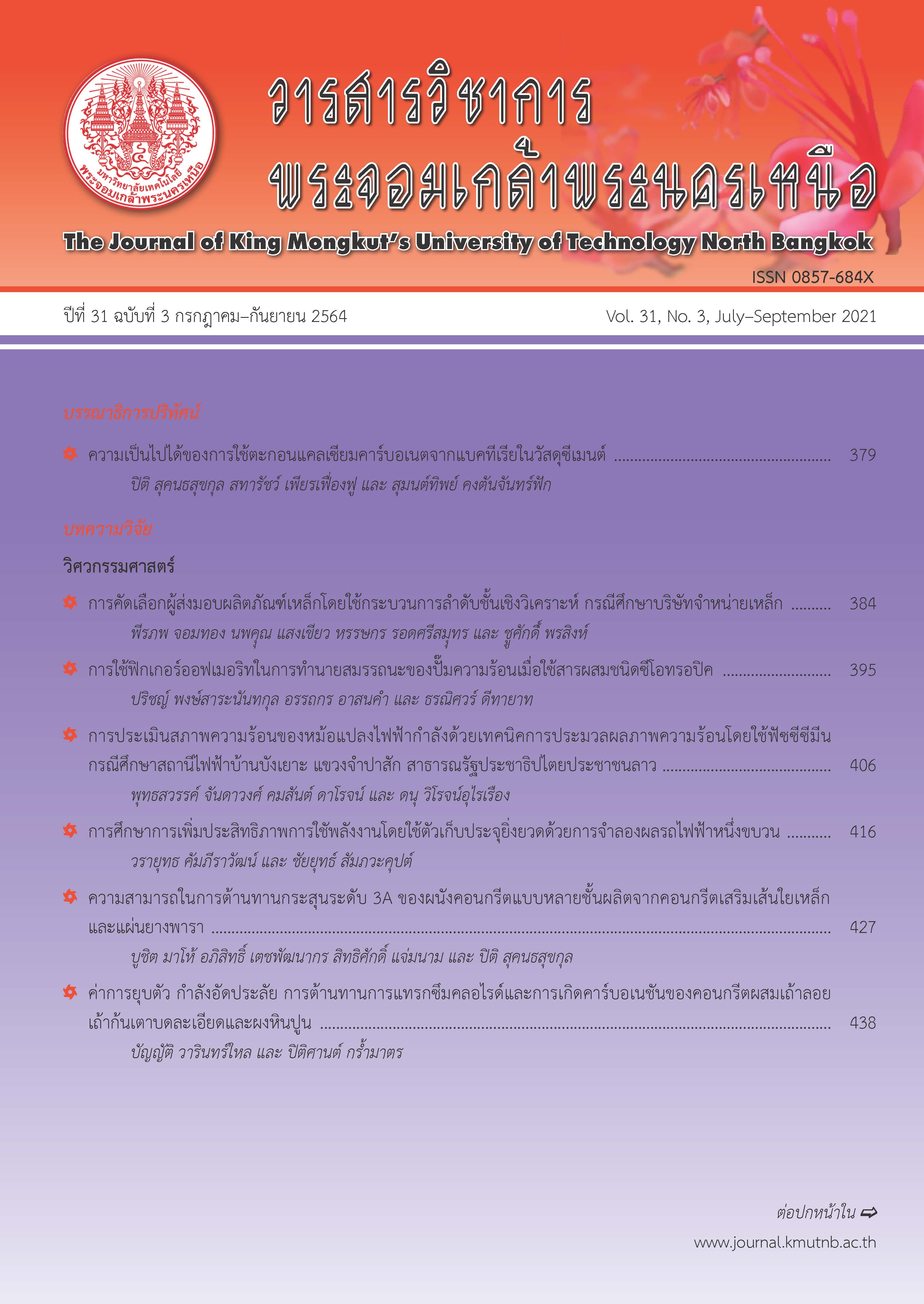การเปรียบเทียบวิธีการหาค่าเหมาะที่สุด ด้วยโซลเวอร์ของโปรแกรมไมโครซอฟท์เอกเซลล์ 2007 และ 2019 กรณีศึกษา ตัวแบบทางด้านสถิติศาสตร์
Main Article Content
บทคัดย่อ
งานวิจัยนี้มีวัตถุประสงค์เพื่อเปรียบเทียบวิธีการหาค่าเหมาะที่สุดในปัญหาเกณฑ์เปรียบเทียบสมรรถนะ 29 ฟังก์ชันวัตถุประสงค์ที่มาจากปัญหาในตัวแบบทางด้านสถิติศาสตร์ 11 ตัวแบบ ด้วยโซลเวอร์ของโปรแกรมไมโครซอฟท์เอกเซลล์ 2007 ที่ประกอบไปด้วย วิธีกำหนดการเชิงเส้น (LP2007) วิธีนิวตัน-ราฟสัน (NR) และเกรเดียนต์สังยุค (CG) และโซลเวอร์ของโปรแกรมไมโครซอฟท์เอกเซลล์ 2019 ที่ประกอบไปด้วย วิธีกำหนดการเชิงเส้น (LP2019) วิธีเกรเดียนต์ลดรูปแบบวางนัยทั่วไป (GRG) และเชิงวิวัฒน์ (EV) แยกกลุ่มในการทดลองเป็นปัญหาตัวแบบกำหนดการเชิงเส้น ใช้วิธี LP2007 และ LP2019 ในการเปรียบเทียบประสิทธิภาพ และ ปัญหาตัวแบบไม่เชิงเส้นใช้วิธี NR CG GRG และ EV ในการเปรียบเทียบประสิทธิภาพ เกณฑ์การตัดสินใจ 2 วิธี คือ 1) ความคาดเคลื่อนสัมบูรณ์เฉลี่ยต่ำที่สุด ( ) และ 2) เวลาเฉลี่ยต่ำที่สุด (ATmin ) เป็นตัวกำหนดวิธีการค้นหาคำตอบที่มีประสิทธิภาพมากที่สุด โดยกำหนดปัญหาเกณฑ์เปรียบเทียบสมรรถนะที่มีคำตอบที่แท้จริงจำนวน 7 ฟังก์ชันวัตถุประสงค์ ใช้วิธีการตัดสินใจด้วยค่า และ ปัญหาเกณฑ์เปรียบเทียบสมรรถนะที่เป็นตัวแบบสโตแคสติกไม่เชิงเส้นจำนวน 22 ฟังก์ชันวัตถุประสงค์ ใช้วิธีการตัดสินใจด้วยค่า และ ทำการทดลองซ้ำในแต่ละสถานการณ์จำนวน 100 รอบ ผลการวิจัยพบว่า 1) ปัญหาเกณฑ์เปรียบเทียบสมรรถนะที่มีคำตอบที่แท้จริง เมื่อปัญหาเป็นการเดินทางของพนักงานขาย LP2019 เป็นวิธีการค้นหาคำตอบที่เร็วกว่า LP2007 แต่ในกรณีตัวแบบไวท์นอยส์ ตัวแบบเชิงเส้น ตัวแบบลอการิทึม ตัวแบบเลขชี้กำลัง และตัวแบบกำลัง ที่ฟังก์ชันวัตถุประสงค์เป็น วิธี NR และ CG ทำงานได้รวดเร็วกว่าวิธี GRG และ EV ในทุกปัญหา และ 2) ปัญหาเกณฑ์เปรียบเทียบสมรรถนะที่เป็นตัวแบบสโตแคสติกไม่เชิงเส้น เมื่อการตัดสินใจด้วยค่า วิธี GRG และ EV เป็นวิธีที่มีประสิทธิภาพมากที่สุดตามลำดับ และเมื่อการตัดสินใจที่ค่า พบว่าวิธี CG และ NR เป็นวิธีที่หาคำตอบได้เร็วมากที่สุดตามลำดับ
Article Details
บทความที่ลงตีพิมพ์เป็นข้อคิดเห็นของผู้เขียนเท่านั้น
ผู้เขียนจะต้องเป็นผู้รับผิดชอบต่อผลทางกฎหมายใดๆ ที่อาจเกิดขึ้นจากบทความนั้น
เอกสารอ้างอิง
[2] M. Somboonrojchai, “The productivity improvement on steel roughing mill,” M.S. thesis, Faculty of Engineering, King Mongkut's University of Technology North Bangkok, 2010 (in Thai).
[3] N. Sedtakomkul, “The applied Monte Carlo simulation method to reorder point and order quantity for purchasing under uncertainties of demand,” M.S. thesis, Faculty of Engineering, King Mongkut's University of Technology North Bangkok, 2011 (in Thai).
[4] A. Chamklin, “Optimization of packing on vehicles: A case study of Srithai Superware Ltd.,” ndependent study, School of Business, The University of the Thai Chamber of Commerce, 2013 (in Thai).
[5] P. Penpakkol and T. Intarakumthornchai, “Inventory management of spare parts under uncertain demand: A case study of particle board manufacturer,” The Journal of KMUTNB, vol 28, no.1, pp. 9–22, 2018 (in Thai).
[6] S. Wititpan, “Application of excel solver to determine optimized parameter for hydrological model,” M.S. thesis, Faculty of Engineering, King Mongkut’s University of Technology Thonburi, 2015 (in Thai).
[7] C. Theppakdee, “Pollution management guideline for medium-sized integarted close system broiler farm,” M.S. thesis, Faculty of Engineering, King Mongkut's Institute of Technology Ladkrabang, 2017 (in Thai).
[8] V.Y. Naimy, “Parameterization of GARCH(1,1) for Paris stock market,” American Journal of Mathematics and Statistics, vol 3, no. 6, pp 357–361, 2013.
[9] F. Farida, “A simplified approach to estimating parameter of the GARCH (1,1) model,” Applied Science and Engineering Progress, vol 12, no. 3, pp. 158–163, 2019.
[10] J. Vasilev, “Solving the traveling salesman problem with the alldifferent constraint in MS Excel,” in Proceedings 5th International Conference on Application of Information and Communication Technology and Statistics in Economy and Education (ICAICTSEE-2015), 2015, pp. 420–423.
[11] P. Minsan and W. Minsan, “Comparing methods of optimization in solver of Microsoft Excel 2007 and 2019,” UTK Research Journal, vol 13, no. 2, pp. 144–161, 2019 (in Thai).
[12] C.E. Miller, A.W. Tucker, and R.A. Zemlin, “Integer programming formulations and traveling salesman problems,”Journal of Association for Computing Machinery 7, pp. 326–329, 1960.
[13] T. Sawik, “A note on the Miller-Tucker-Zemlin model for the asymmetric traveling salesman problem,” Bulletin of the Polish Academy of Sciences Technical Sciences, vol. 64, no. 3, pp. 517–520, 2016.

